MITSUBISHI GALANT 1989 Service Repair Manual
Manufacturer: MITSUBISHI, Model Year: 1989, Model line: GALANT, Model: MITSUBISHI GALANT 1989Pages: 1273, PDF Size: 37.62 MB
Page 101 of 1273
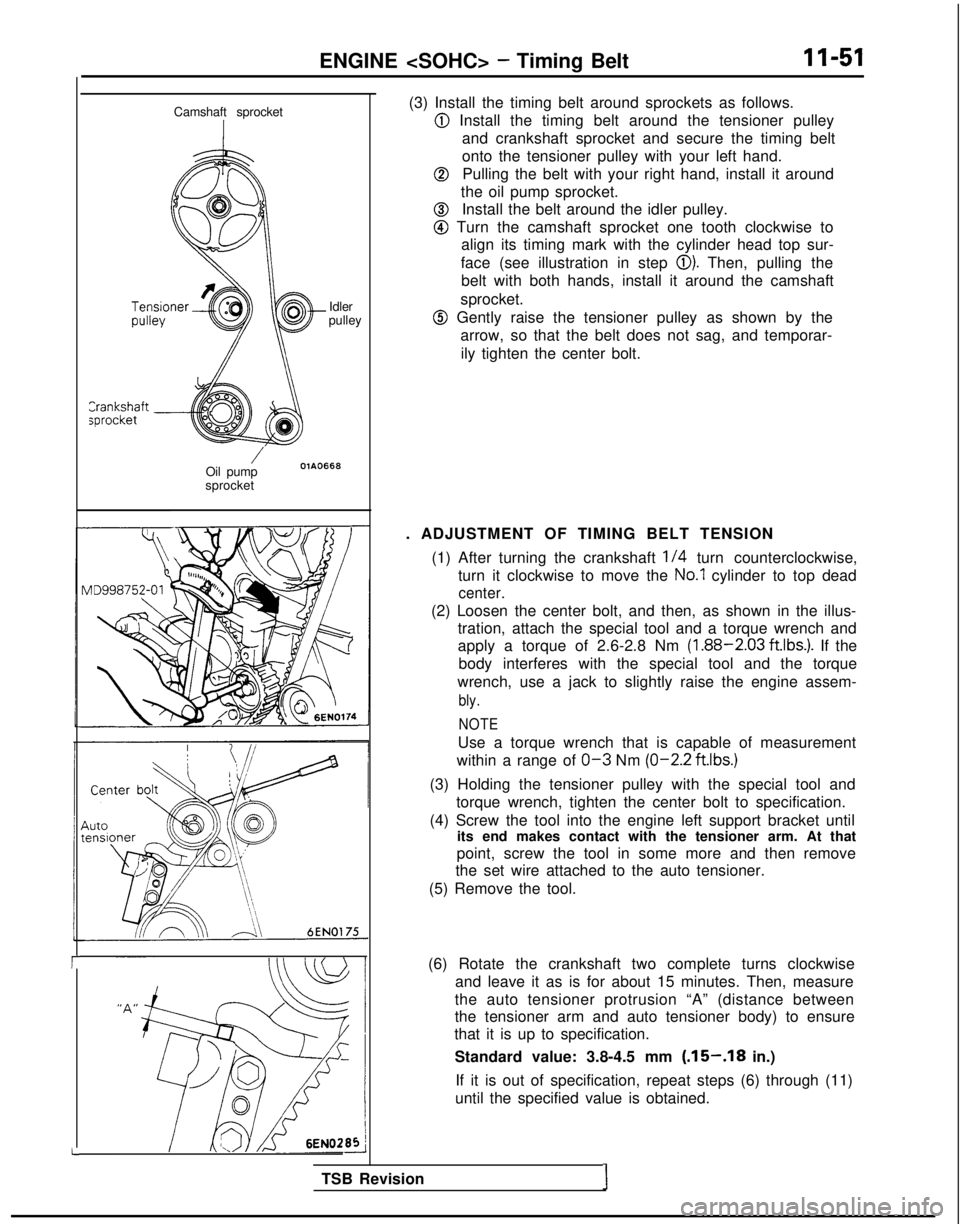
ENGINE
r
L Camshaft sprocket
Idler
pulley
/Oil pumpOlA0668
sprocket
6EN0175
(3) Install the timing belt around sprockets as follows.
@ Install the timing belt around the tensioner pulley
and crankshaft sprocket and secure the timing belt
onto the tensioner pulley with your left hand.
@Pulling the belt with your right hand, install it around
the oil pump sprocket.
@Install the belt around the idler pulley.
@ Turn the camshaft sprocket one tooth clockwise to align its timing mark with the cylinder head top sur-
face (see illustration in step
0). Then, pulling the
belt with both hands, install it around the camshaft
sprocket.
@ Gently raise the tensioner pulley as shown by the arrow, so that the belt does not sag, and temporar-
ily tighten the center bolt.
. ADJUSTMENT OF TIMING BELT TENSION (1) After turning the crankshaft
l/4 turn counterclockwise,
turn it clockwise to move the
No.1 cylinder to top dead
center.
(2) Loosen the center bolt, and then, as shown in the illus- tration, attach the special tool and a torque wrench and
apply a torque of 2.6-2.8 Nm
(1.88-2.03 ft.lbs.). If the
body interferes with the special tool and the torque
wrench, use a jack to slightly raise the engine assem-
bly.
NOTE
Use a torque wrench that is capable of measurement
within a range of
O-3 Nm (O-2.2
ftlbs.)
(3) Holding the tensioner pulley with the special tool and
torque wrench, tighten the center bolt to specification.
(4) Screw the tool into the engine left support bracket until its end makes contact with the tensioner arm. At that
point, screw the tool in some more and then remove
the set wire attached to the auto tensioner.
(5) Remove the tool.
(6) Rotate the crankshaft two complete turns clockwise and leave it as is for about 15 minutes. Then, measure
the auto tensioner protrusion “A” (distance between
the tensioner arm and auto tensioner body) to ensure
that it is up to specification.
Standard value: 3.8-4.5 mm
(.15-.18 in.)
If it is out of specification, repeat steps (6) through (11)
until the specified value is obtained.
TSB Revision
I
Page 102 of 1273
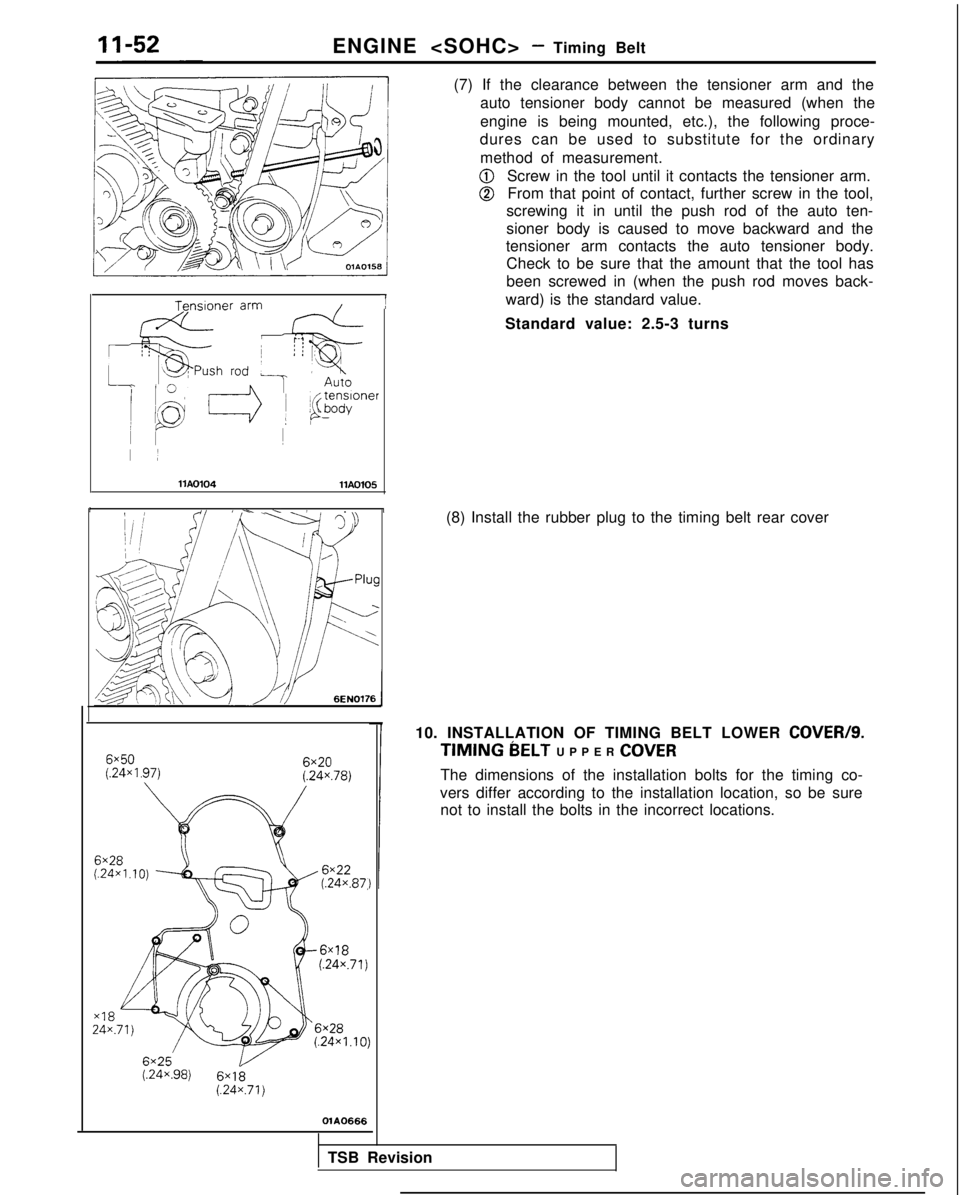
ENGINE
riiis;;o;~~@
1 ip I-----$ j ggoner
~
I :
1
llAO104
1lAOlOS
II, /K. I . I
6x50
(.24x1.97)6x20(.24x.78)
6x22(.24x.87,
6x18(.24x.71)
6x251.24x.98)6x18(.24x.71)
OlAO666
(7) If the clearance between the tensioner arm and the
auto tensioner body cannot be measured (when the
engine is being mounted, etc.), the following proce-
dures can be used to substitute for the ordinary
method of measurement.
@Screw in the tool until it contacts the tensioner arm.
@From that point of contact, further screw in the tool,
screwing it in until the push rod of the auto ten-
sioner body is caused to move backward and the
tensioner arm contacts the auto tensioner body. Check to be sure that the amount that the tool has
been screwed in (when the push rod moves back-
ward) is the standard value.
Standard value: 2.5-3 turns
(8) Install the rubber plug to the timing belt rear cover
10. INSTALLATION OF TIMING BELT LOWER COVER/S.
TIMING MELT UPPER
COVER
The dimensions of the installation bolts for the timing co-
vers differ according to the installation location, so be sure not to install the bolts in the incorrect locations.
TSB Revision
Page 103 of 1273
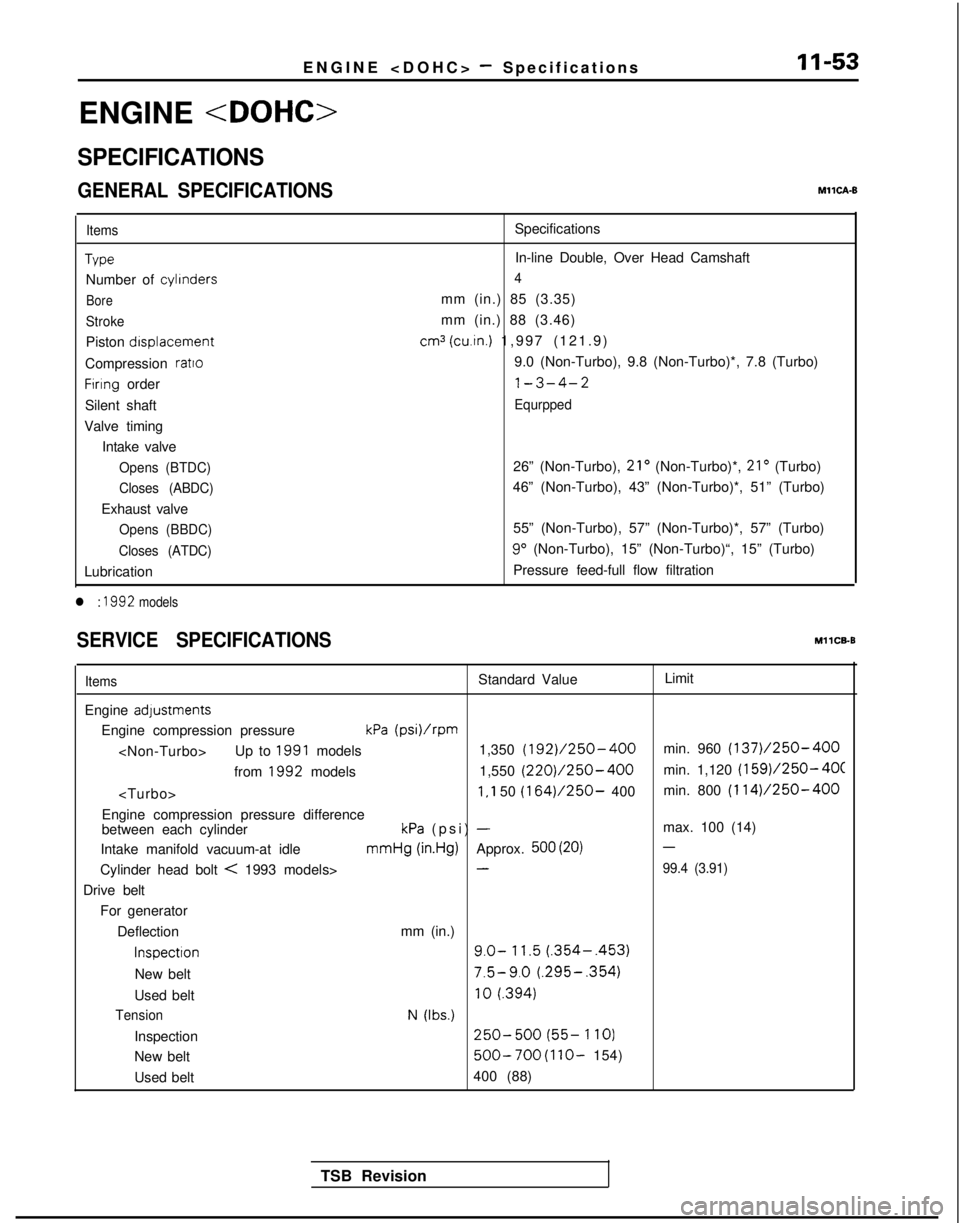
ENGINE
s
ENGINE
SPECIFICATIONS
GENERAL SPECIFICATIONSMllCA-6
Items
Tvpe
Number of
cylinders
Bore
Stroke
Piston
drsplacement
Compression
ratto
Firing order
Silent shaft
Valve timing Intake valve
Opens (BTDC)
Closes (ABDC)
Exhaust valve
Opens (BBDC)
Closes (ATDC)
Lubrication
l : 1992 models
Specifications
In-line Double, Over Head Camshaft
4
mm (in.) 85 (3.35)
mm (in.) 88 (3.46)
cm3 (cu.in.) 1,997 (121.9
)
9.0 (Non-Turbo), 9.8 (Non-Turbo)*, 7.8 (Turbo)
l-3-4-2
Equrpped
26” (Non-Turbo), 21’ (Non-Turbo)*, 21’ (Turbo)
46” (Non-Turbo), 43” (Non-Turbo)*, 51” (Turbo)
55” (Non-Turbo), 57” (Non-Turbo)*, 57” (Turbo) 9”
(Non-Turbo), 15” (Non-Turbo)“, 15” (Turbo)
Pressure feed-full flow filtration
SERVICE SPECIFICATIONSMllCB-B
ItemsStandard Value Limit
Engine
adystments
Engine compression pressurekPa (psi)/rpm
from 1992
models 1,550 (220)/250-400min. 1,120 (159)/250- 4OC
Engine compression pressure difference
between each cylinderkPa (psi) -max. 100 (14)
Intake manifold vacuum-at idle mmHg
(in.Hg)Approx. 500 (20)-
Cylinder head bolt < 1993 models>-99.4 (3.91)
Drive belt
For generator
Deflection mm (in.)
Inspectron9.0- 11.5 (.354-.453)
New belt7.5-9.0 (.295-.354)
Used belt10
f.394)
TensionN (Ibs.)
Inspection250-500 (55- 1
IO)
New belt
500-700 (1 lo- 154)
Used belt 400 (88)
TSB Revision
Page 104 of 1273
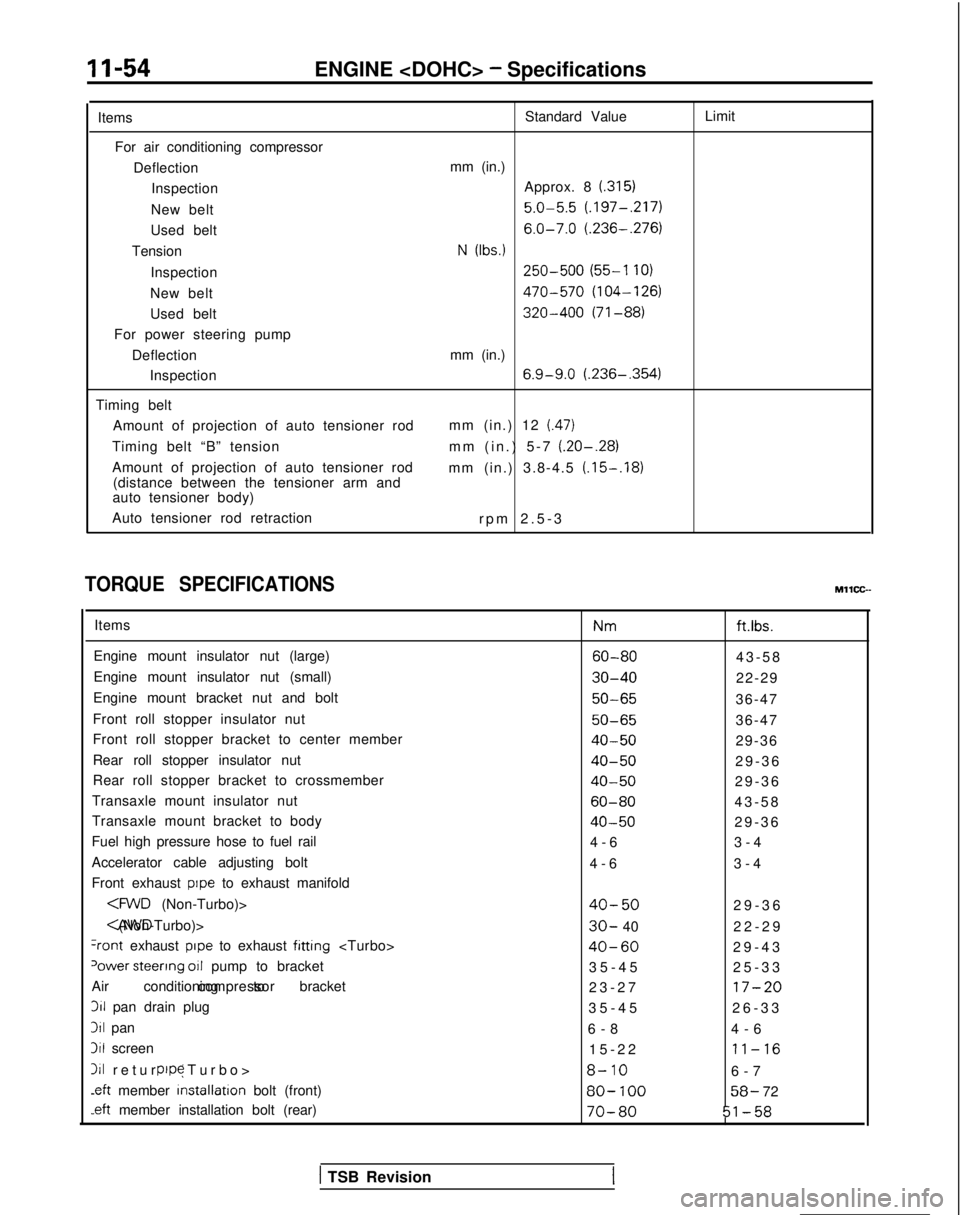
11-54ENGINE
Items For air conditioning compressor DeflectionInspection
New belt
Used belt
Tension
Inspection
New belt
Used belt
For power steering pump
DeflectionInspection
Timing belt Amount of projection of auto tensioner rod
Timing belt “B” tension
Amount of projection of auto tensioner rod (distance between the tensioner arm and
auto tensioner body)
Auto tensioner rod retraction Standard Value
mm (in.) Approx. 8
(.315)
5.0-5.5 (.197-,217)
6.0-7.0 (.236-.276)
N (Ibs.)
250-500 (55-l 10)
470-570 (104-126)
320-400 (71-88)
mm (in.)
6.9-9.0 (.236-,354)
mm (in.) 12 (.47)
mm (in.) 5-7 (.20-.28)
mm (in.) 3.8-4.5 (.15-.18)
rpm 2.5-
3
Limit
TORQUE SPECIFICATIONS
Items
Engine mount insulator nut (large)
Engine mount insulator nut (small)
Engine mount bracket nut and bolt
Front roll stopper insulator nut
Front roll stopper bracket to center member
Rear roll stopper insulator nut
Rear roll stopper bracket to crossmember
Transaxle mount insulator nut
Transaxle mount bracket to body
Fuel high pressure hose to fuel rail
Accelerator cable adjusting bolt
Front exhaust
pope to exhaust manifold
+ont exhaust pope to exhaust fitting
‘ower steerrng 011 pump to bracket
Air conditioning to bracket compressor311
pan drain plug
311 pan
3il screen
111 return (Turbo
>
pope
.eft
member installation
bolt (front)
-eft member installation bolt (rear) Nm
ft.ibs.
60-8043-5
8
30-4022-29
50-6536-47
50-6536-47
40-5029-36
40-5029-3
6
40-5029-3
6
60-8043-5
8
40-5029-3
6
4-6 3-4
4-6 3-4
40-5029-3
6
30- 40
22-2
9
40-6029-4
3
35-45 25-33
23-27
17-20
35-4
5
26-33
6-8 4-6
15-22
11-16
8-106-
7
80-
10058- 72
70-8051-58
MllCC--
( TSB Revision
Page 105 of 1273
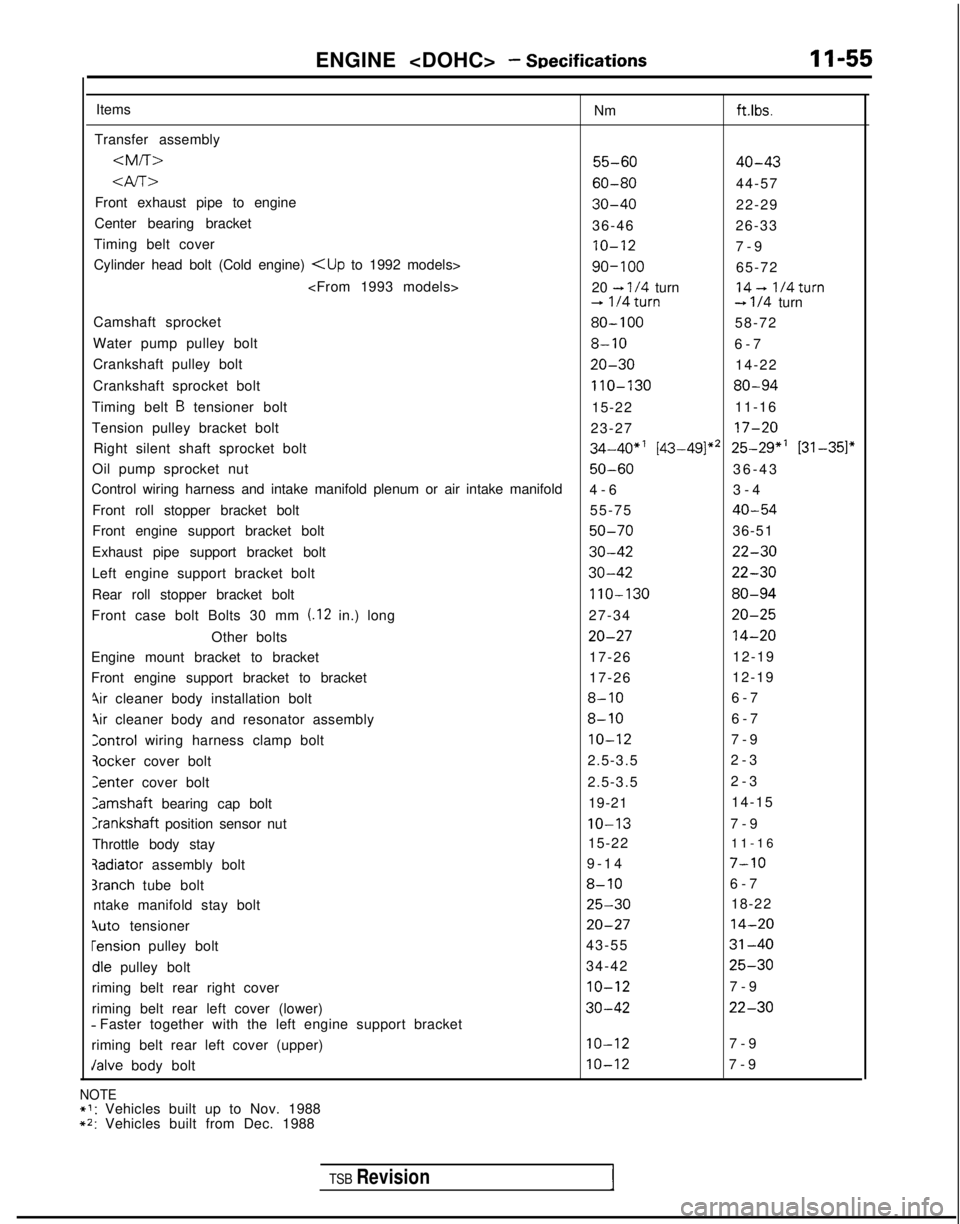
ENGINE
Items Nm
ft.lbs.
Transfer assembly
4f-r>60-8044-57
Front exhaust pipe to engine
30-4022-29
Center bearing bracket 36-4626-33
Timing belt cover
IO-127-
9
Cylinder head bolt (Cold engine)
-t l/4 turn14- 1/4turn+ 1!4turn--t l/4 turn
Camshaft sprocket
80-10058-72
Water pump pulley bolt
8-106-
7
Crankshaft pulley bolt
20-3014-22
Crankshaft sprocket bolt
110-13080-94
Timing belt B tensioner bolt 15-2211-16
Tension pulley bracket bolt 23-27
17-20
Right silent shaft sprocket bolt34-40*' [43-49]** 25-29*’ 131-351"
Oil pump sprocket nut50-6036-4
3
Control wiring harness and intake manifold plenum or air intake manifold\
4-63-4
Front roll stopper bracket bolt 55-75
40-54
Front engine support bracket bolt50-7036-51
Exhaust pipe support bracket bolt
30-4222-30
Left engine support bracket bolt30-4222-30
Rear roll stopper bracket bolt110-13080-94
Front case bolt Bolts 30 mm (.I2 in.) long 27-3420-25
Other bolts20-2714-20
Engine mount bracket to bracket 17-2612-19
Front engine support bracket to bracket 17-2612-19
%r cleaner body installation bolt8-106-
7
qir cleaner body and resonator assembly8-106-
7
Control wiring harness clamp boltIO-127-
9
3ocker
cover bolt 2.5-3.5
2-3Zenter
cover bolt 2.5-3.52-3Camshaft
bearing cap bolt 19-2114-15
Crankshaft position sensor nutIO-137-
9
Throttle body stay 15-22
11-163adiator
assembly bolt 9-14
7-10
3ranch tube bolt8-106-
7
ntake manifold stay bolt
25-3018-22
quto tensioner20-2714-20 rension
pulley bolt 43-55
31-40dle
pulley bolt 34-42
25-30
riming belt rear right cover10-127-
9
riming belt rear left cover (lower)
30-4222-30 - Faster together with the left engine support bracket
riming belt rear left cover (upper)
IO-127-
9
Jalve body boltIO-127-
9
NOTE*I: Vehicles built up to Nov. 1988**: Vehicles built from Dec. 1988
TSB Revision1
Page 106 of 1273
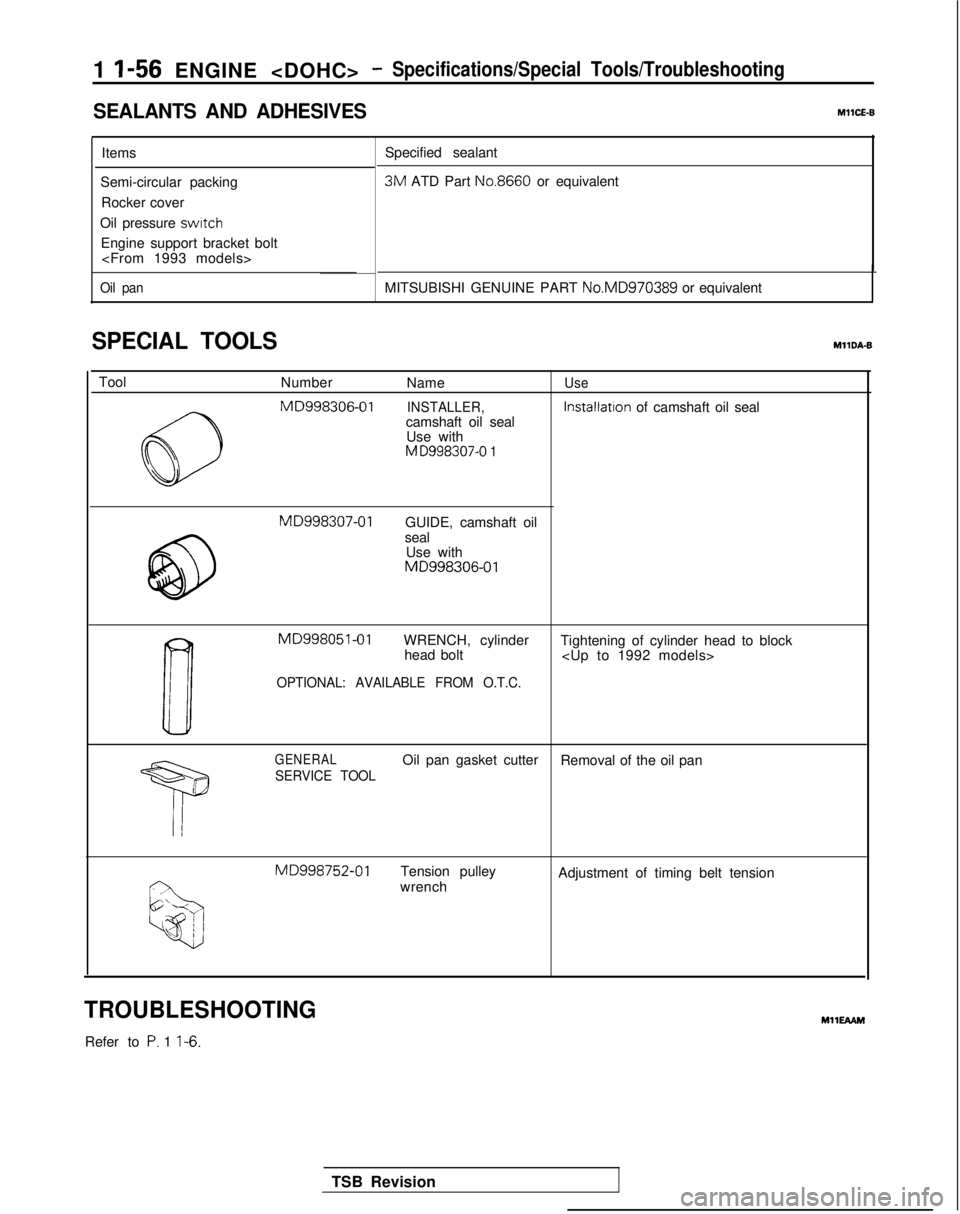
1 l-56 ENGINE
SEALANTS AND ADHESIVES
MllCE-B
Items
Semi-circular packing Rocker cover
Oil pressure switch
Engine support bracket bolt
Oil panMITSUBISHI GENUINE PART No.MD970389
or equivalent
Specified sealant 3M
ATD Part No.8660
or equivalent
SPECIAL TOOLSMllDA-8
Tool
NumberNameUse
0 MD998306-01
INSTALLER,
lnstallatlon
of camshaft oil seal
camshaft oil seal
0
Use withM D998307-0 1 MD998307-01
GUIDE, camshaft oil
@
seal
Use with MD998306-01
II
MD998051-01
WRENCH, cylinder
head bolt Tightening of cylinder head to block
OPTIONAL: AVAILABLE FROM O.T.C.
T
GENERALOil pan gasket cutter Removal of the oil pan
r-SERVICE TOOL MD998752-01
Tension pulley
wrench Adjustment of timing belt tension
TROUBLESHOOTING
Refer to P. 1 l-6.
TSB Revision
Page 107 of 1273
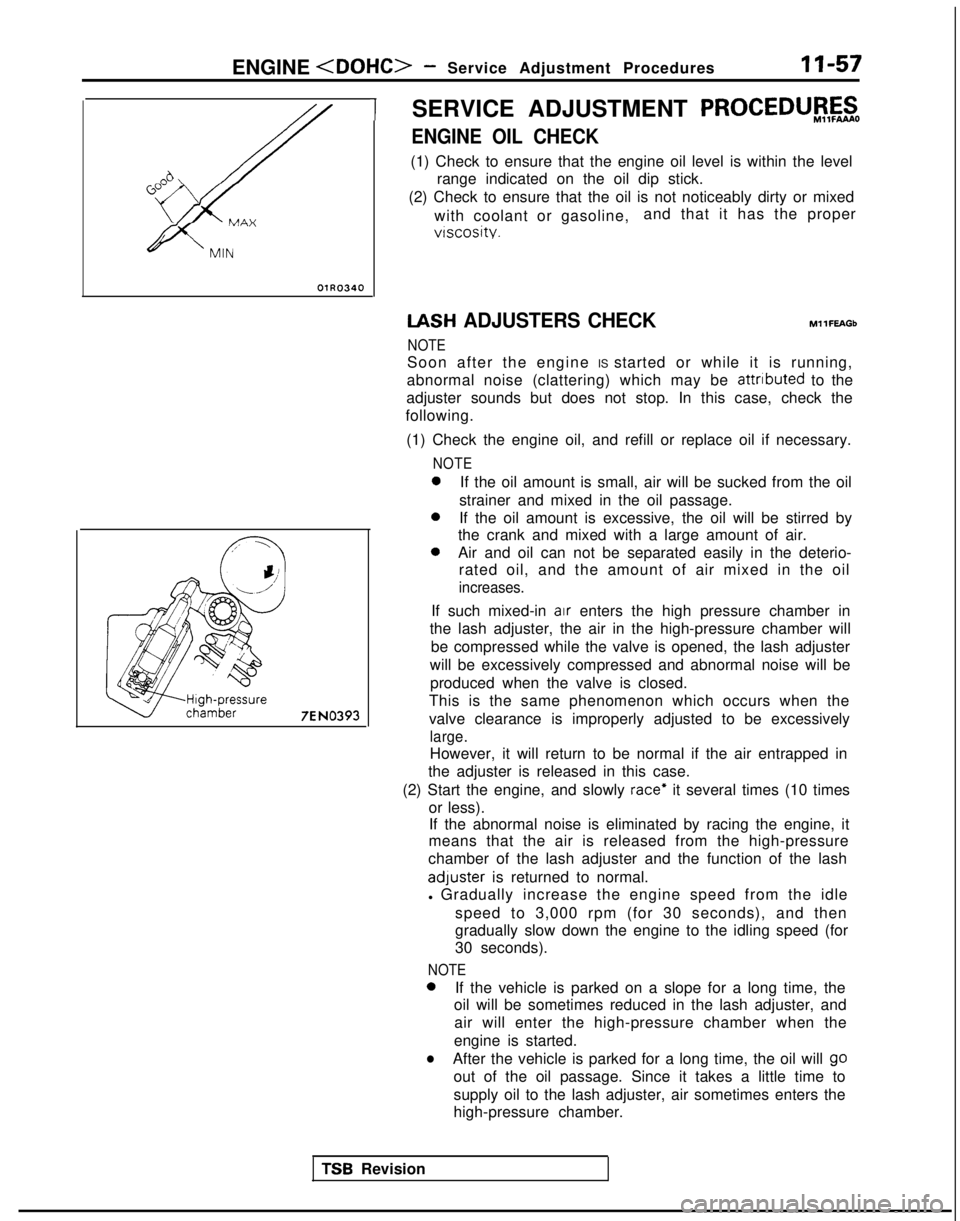
ENGINE
OlR0340
7EN0393
1SERVICE ADJUSTMENT PROCEDUBFzo
ENGINE OIL CHECK
(1) Check to ensure that the engine oil level is within the level
range indicated on the oil dip stick.
(2) Check to ensure that the oil is not noticeably dirty or mixed
with coolant or gasoline, and that it has the proper
vtscosity. IASH
ADJUSTERS CHECK
NOTE MllFEAGb
Soon after the engine IS started or while it is running,
abnormal noise (clattering) which may be attributed
to the
adjuster sounds but does not stop. In this case, check the
following.
(1) Check the engine oil, and refill or replace oil if necessary.
NOTE 0
If the oil amount is small, air will be sucked from the oil
strainer and mixed in the oil passage. 0
If the oil amount is excessive, the oil will be stirred by
the crank and mixed with a large amount of air. 0
Air and oil can not be separated easily in the deterio-
rated oil, and the amount of air mixed in the oil
increases.
If such mixed-in air enters the high pressure chamber in
the lash adjuster, the air in the high-pressure chamber will
be compressed while the valve is opened, the lash adjuster
will be excessively compressed and abnormal noise will be produced when the valve is closed.
This is the same phenomenon which occurs when the
valve clearance is improperly adjusted to be excessively
large.
However, it will return to be normal if the air entrapped in
the adjuster is released in this case.
(2) Start the engine, and slowly
race* it several times (10 times
or less). If the abnormal noise is eliminated by racing the engine, it
means that the air is released from the high-pressure
chamber of the lash adjuster and the function of the lash adluster
is returned to normal.
l Gradually increase the engine speed from the idle
speed to 3,000 rpm (for 30 seconds), and then
gradually slow down the engine to the idling speed (for
30 seconds).
NOTE 0
If the vehicle is parked on a slope for a long time, the
oil will be sometimes reduced in the lash adjuster, and
air will enter the high-pressure chamber when the
engine is started.
lAfter the vehicle is parked for a long time, the oil will go
out of the oil passage. Since it takes a little time to
supply oil to the lash adjuster, air sometimes enters the
high-pressure chamber.
TSR Revision
Page 108 of 1273
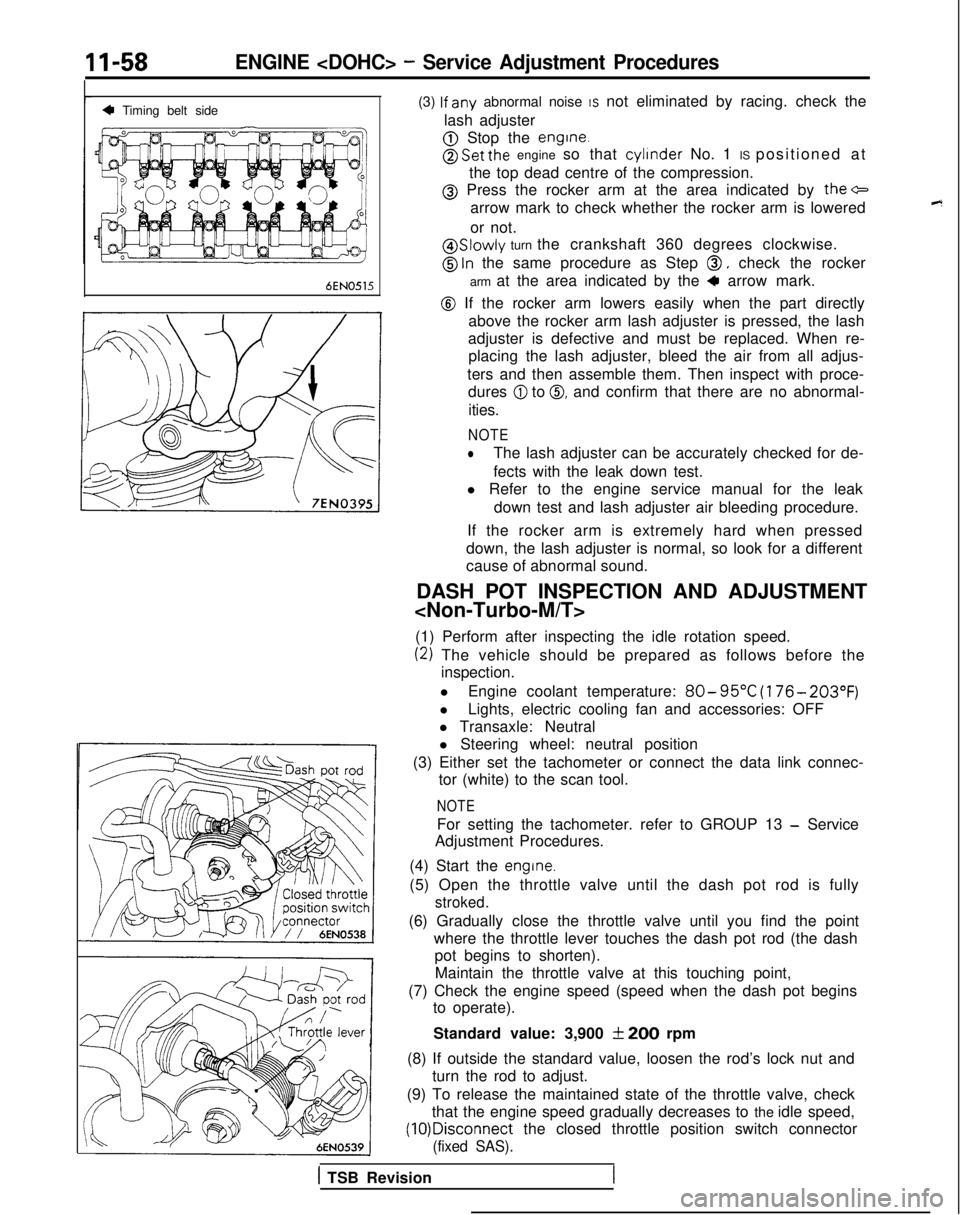
11-58ENGINE
4 Timing belt sideI
6EN0515
(3) lf
any abnormal noise IS not eliminated by racing. check the
lash adjuster
@ Stop the engine.
@ Set the engine so that cylinder
No. 1 IS positioned at
the top dead centre of the compression.
@ Press the rocker arm at the area indicated by the+
arrow mark to check whether the rocker arm is lowered
or not.
@ Slowly turn the crankshaft 360 degrees clockwise.
@ ln the same procedure as Step 0, check the rocker
arm at the area indicated by the
4 arrow mark.
@ If the rocker arm lowers easily when the part directly above the rocker arm lash adjuster is pressed, the lash
adjuster is defective and must be replaced. When re- placing the lash adjuster, bleed the air from all adjus-
ters and then assemble them. Then inspect with proce- dures
@I to 0, and confirm that there are no abnormal-
ities.
NOTE
lThe lash adjuster can be accurately checked for de-
fects with the leak down test.
l Refer to the engine service manual for the leak
down test and lash adjuster air bleeding procedure.
If the rocker arm is extremely hard when pressed
down, the lash adjuster is normal, so look for a different
cause of abnormal sound.
DASH POT INSPECTION AND ADJUSTMENT
(1) Perform after inspecting the idle rotation speed.
(2) The vehicle should be prepared as follows before the inspection.
l Engine coolant temperature:
80- 95°C
(176- 203°F)
lLights, electric cooling fan and accessories: OFF
l Transaxle: Neutral
l Steering wheel: neutral position
(3) Either set the tachometer or connect the data link connec- tor (white) to the scan tool.
NOTE
For setting the tachometer. refer to GROUP 13 - Service
Adjustment Procedures.
(4) Start the
engine.
(5) Open the throttle valve until the dash pot rod is fully
stroked.
(6) Gradually close the throttle valve until you find the point where the throttle lever touches the dash pot rod (the dashpot begins to shorten).
Maintain the throttle valve at this touching point,
(7) Check the engine speed (speed when the dash pot begins to operate).
Standard value: 3,900
f 200 rpm
(8) If outside the standard value, loosen the rod’s lock nut and turn the rod to adjust.
(9) To release the maintained state of the throttle valve, check that the engine speed gradually decreases to the idle speed, (10)Disconnect
the closed throttle position switch connector
(fixed SAS).
1 TSB Revision
Page 109 of 1273
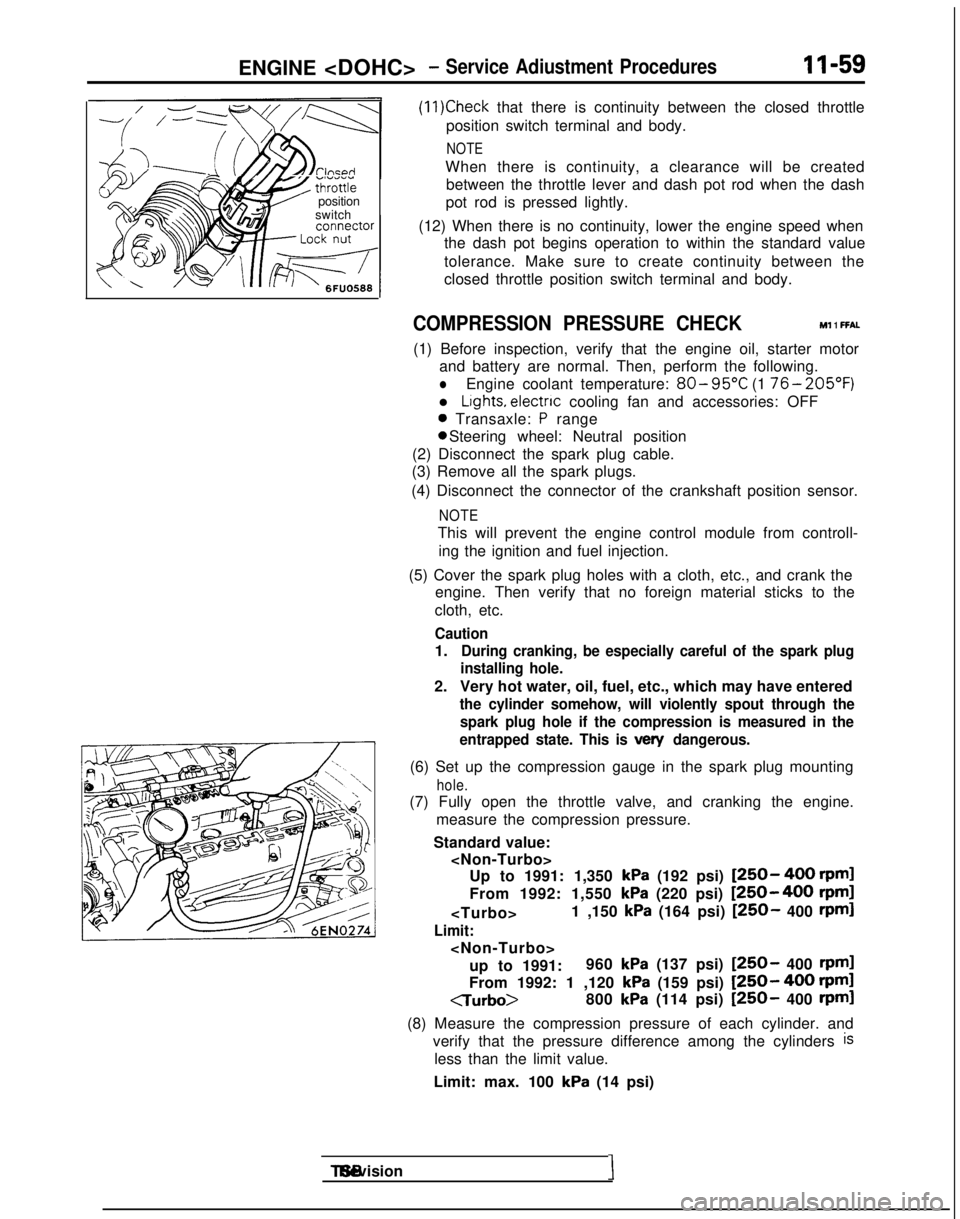
ENGINE
7 Go;;ikv position
switch
(11)Check that there is continuity between the closed throttle
position switch terminal and body.
NOTE
When there is continuity, a clearance will be created between the throttle lever and dash pot rod when the dash
pot rod is pressed lightly.
(12) When there is no continuity, lower the engine speed when the dash pot begins operation to within the standard value
tolerance. Make sure to create continuity between the
closed throttle position switch terminal and body.
COMPRESSION PRESSURE CHECK Ml 1 FFAL
(1) Before inspection, verify that the engine oil, starter motor
and battery are normal. Then, perform the following.
lEngine coolant temperature: 80- 95°C
(1 76- 205’F)
l Lights, electnc
cooling fan and accessories: OFF
0 Transaxle: P range 0 Steering wheel: Neutral position
(2) Disconnect the spark plug cable.
(3) Remove all the spark plugs.
(4) Disconnect the connector of the crankshaft position sensor.
NOTE
This will prevent the engine control module from controll- ing the ignition and fuel injection.
(5) Cover the spark plug holes with a cloth, etc., and crank the engine. Then verify that no foreign material sticks to the
cloth, etc.
Caution
1.During cranking, be especially careful of the spark plug
installing hole.
2. Very hot water, oil, fuel, etc., which may have entered
the cylinder somehow, will violently spout through the
spark plug hole if the compression is measured in the
entrapped state. This is
vex/ dangerous.
(6) Set up the compression gauge in the spark plug mounting
hole.
(7) Fully open the throttle valve, and cranking the engine.
measure the compression pressure.
Standard value:
kPa (192 psi) [250- 400 rpml
From 1992: 1,550
kPa (220 psi) [250-400 rpm]
Limit:
up to 1991: 960
kPa (137 psi) [250- 400 rpml
From 1992: 1 ,120 kPa (159 psi) [250- 400 rpml
CTurbo>
800
kPa (114 psi) [250- 400 rpml
(8) Measure the compression pressure of each cylinder. and verify that the pressure difference among the cylinders
is
less than the limit value.
Limit: max. 100
kPa (14 psi) TSB Revision
I
Page 110 of 1273
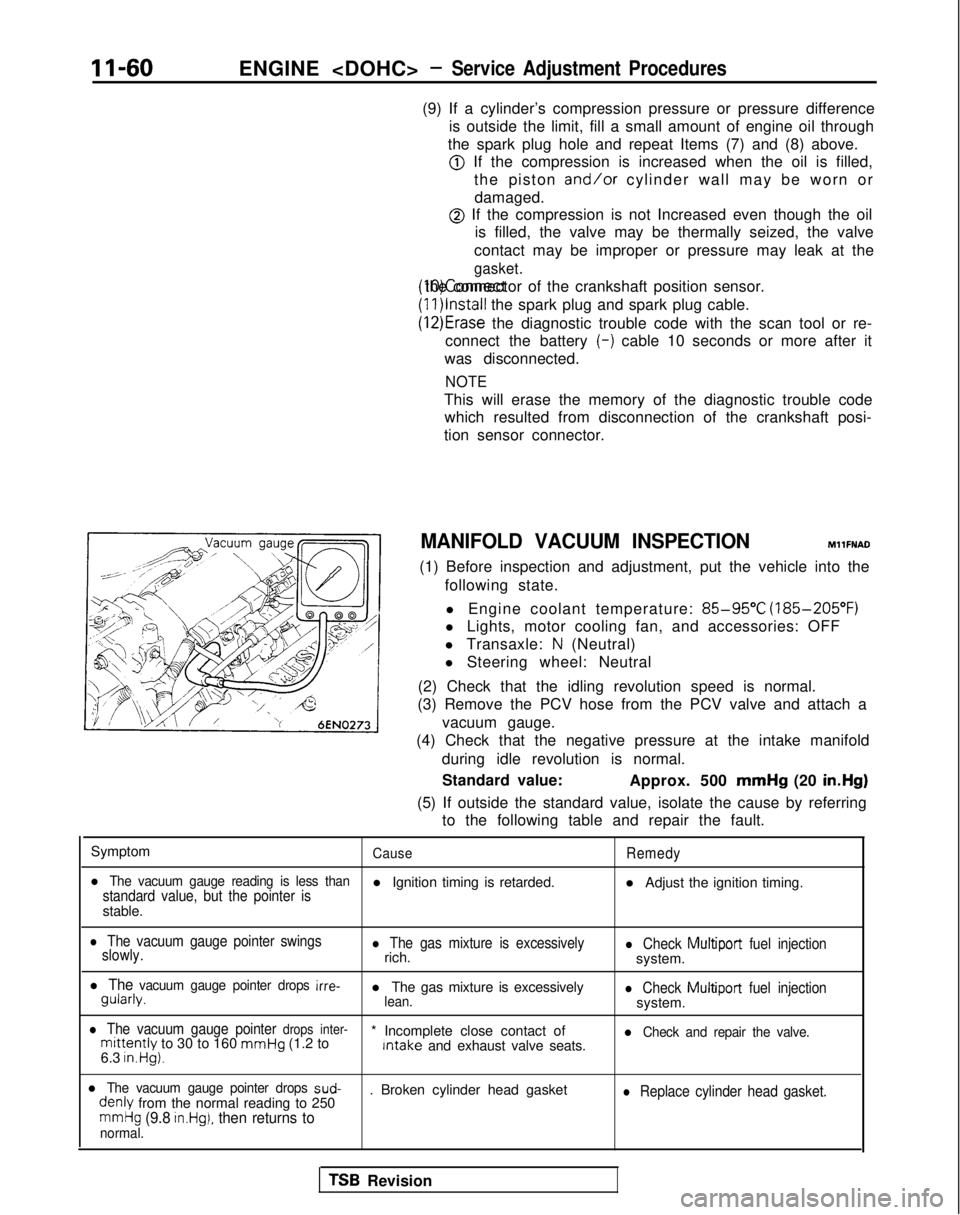
II-60ENGINE
(9) If a cylinder’s compression pressure or pressure differenceis outside the limit, fill a small amount of engine oil through
the spark plug hole and repeat Items (7) and (8) above.
@ If the compression is increased when the oil is filled, the piston
and/or cylinder wall may be worn or
damaged.
@ If the compression is not Increased even though the oil is filled, the valve may be thermally seized, the valve
contact may be improper or pressure may leak at the
gasket. (10)Connect the connector of the crankshaft position sensor.
(1l)lnstall
the spark plug and spark plug cable.
(12)Erase the diagnostic trouble code with the scan tool or re-
connect the battery (-)
cable 10 seconds or more after it
was disconnected.
NOTE
This will erase the memory of the diagnostic trouble code which resulted from disconnection of the crankshaft posi-
tion sensor connector.
MANIFOLD VACUUM INSPECTION MllFNAD
(1) Before inspection and adjustment, put the vehicle into the following state.
l Engine coolant temperature:
85-95°C (185-205°F)
l Lights, motor cooling fan, and accessories: OFF
l Transaxle:
N (Neutral)
l Steering wheel: Neutral
(2) Check that the idling revolution speed is normal.
(3) Remove the PCV hose from the PCV valve and attach a
vacuum gauge.
(4) Check that the negative pressure at the intake manifold
during idle revolution is normal.
Standard value: Approx. 500 mmHg
(20 in.Hg)
(5) If outside the standard value, isolate the cause by referring to the following table and repair the fault.
Symptom
CauseRemedy
l The vacuum gauge reading is less thanstandard value, but the pointer isl Ignition timing is retarded. l Adjust the ignition timing.
stable.
l The vacuum gauge pointer swings
slowly.l The gas mixture is excessivelyrich.l Check Multiport fuel injectionsystem.
l The vacuum gauge pointer drops irre- gularly.
l The gas mixture is excessively
lean.l Check Multiport
fuel injectionsystem.
l The vacuum gauge pointer drops inter-mittently to 30 to 160 mmHg
(1.2 to * Incomplete close contact of Intake
and exhaust valve seats.l Check and repair the valve.
6.3 in.Hg).
l The vacuum gauge pointer drops sud- denly
from the normal reading to 250 . Broken cylinder head gasketl Replace cylinder head gasket.
mmHg (9.8 in.Hg), then returns tonormal.
TSB Revision